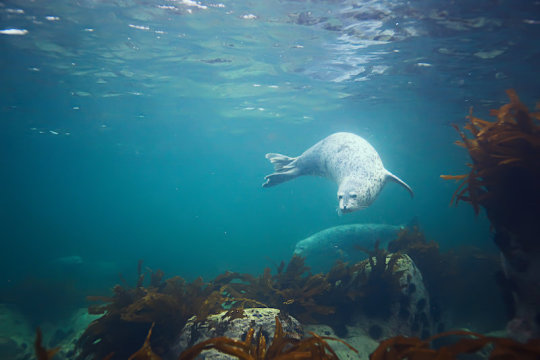[ad_1]
A wearable non-invasive device based on near-infrared spectroscopy (NIRS) can be used to investigate blood volume and oxygenation patterns in freely diving marine mammals, according to a study publishing June 18 in the open-access journal PLOS Biology by J. Chris McKnight of the University of St. Andrews, and colleagues. The results provide new insights into how voluntarily diving seals distribute blood and manage the oxygen supply to their brains and blubber, yielding important information about the basic physiological patterns associated with diving.
In response to submersion in water, mammals show a suite of cardiovascular responses such as reduced heart rate and constriction of peripheral blood vessels. But investigating dive-by-dive blood distribution and oxygenation in marine mammals has up to now been limited by a lack of non-invasive technology that can be used in freely diving animals.
The authors hypothesized that NIRS could address this gap in knowledge by providing high-resolution relative measures of oxygenated and deoxygenated hemoglobin within specific tissues, which can in turn be used to estimate changes in blood volume. In the new study, McKnight and colleagues adapted NIRS technology for use on freely diving harbor seals to investigate blood volume and oxygenation patterns specifically in the brain and blubber, using a device that they dub the PortaSeal.
The authors used the PortaSeal to obtain detailed continuous NIRS data from four seals swimming freely in a quasi-natural foraging habitat. The device is superglued to the animals’ fur; either on their heads to measure cerebral blood, or on the shoulder to monitor peripheral circulation; it is then easily removed, and the data downloaded.
Intriguingly, the results showed that seals routinely constrict their peripheral blood vessels, accompanied by increased cerebral blood volume, approximately 15 seconds before submersion. These anticipatory adjustments suggest that blood redistribution in seals is under some degree of cognitive control and is not just a reflex response to submersion. Seals also routinely increase cerebral oxygenation at a consistent time during each dive, despite a lack of access to air.
The authors propose that the ability to track blood volume and oxygenation in different tissues using NIRS will enable a more accurate understanding of physiological plasticity in diving animals in what is an increasingly disturbed and exploited environment.
“Discovering that seals, which are physiologically fascinating animals, can seemingly actively exert control over their circulatory systems is really exciting,” Said Dr McKnight. “It gives a new perspective on the capacity to control the body’s fundamental physiological responses. Getting this insight with non-invasive wearable technology from the bio-medical field offers many exciting future research avenues. We can start to study organs, like the brain, of seals in the open ocean performing exceptional feats like diving to 2000m for 2hrs with heart rates as low as 2bpm, and yet somehow avoid brain trauma.”
Story Source:
Materials provided by PLOS. Note: Content may be edited for style and length.
[ad_2]















